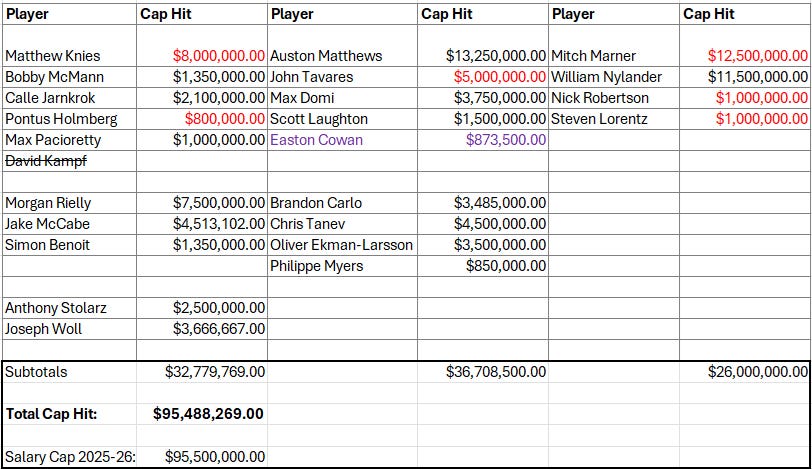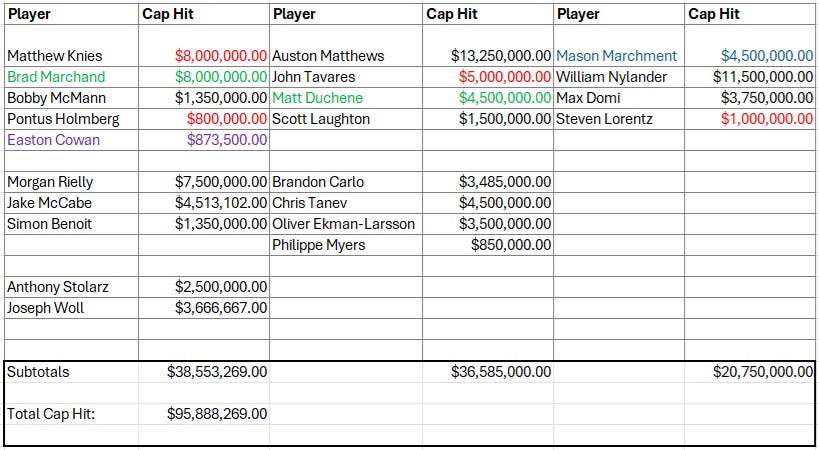Leafs roster projections, without mentioning "DNA"!
Two years ago it was snot, this year it's DNA. Brad, we get the picture.
The only core 4 narrative that ever made sense was that you can’t build the depth of a champion when half your salary goes to 4 players. With Marner all-but-gone, the only silver lining is the opportunity to address that depth problem in a meaningful way.
There will be 3 keys to a successful re-tool:
Taking advantage of teams that are up against the cap (e.g., Dallas and Colorado).
Not spending all their newfound cap space in one shot. Ideally, they add at least 2 impact players for what it would cost to keep Marner.
Stop the trend of over-paying their stars to stay in Toronto.
I’ve put together three examples of what their roster might look like, and where it might change for the better. It doesn’t have to be a step-back year.
Example 1: Everyone is back (except Kampf)
First, as a baseline, here’s what their roster would be if they brought everyone back (except Kampf), with estimated salaries in red for re-signed free agents. Easton Cowan (in purple) is already signed, but wasn’t on the roster last year.
As per one of my keys above, in all the scenarios I lay out, the Leafs can’t overpay to re-sign their own free agents. If Tavares wants more than $5 million, it’s time to move on. $8 million for Knies is reasonable for an 8-year deal, or he signs for less annual salary for fewer years as a bridge deal.
[Note: Salary cap for 2025-26 season is $95.5 million. All salaries for the Leafs and other players profiled are from puckpedia.com.]
The good news: they could afford to bring back Marner (if he wants to stay and agrees to a reasonable salary — e.g., close to Mikko Rantanen’s 8x$12 million; Rantanen has comparable regular season numbers and superior playoff stats). There’s also room to have Max Pacioretty and Easton Cowan as extras on the active roster, although most expect Cowan will start in the minors.
The bad news: this won’t improve their depth. Tavares would still be the second-line center (great regular season, but outplayed by Florida’s 2C - Sam Bennett), and their third-line would be average at best with either Max Domi (defensive liability) or Scott Laughton (weak offensively) at center.
Example 2: Big game hunting in free agency
Want to instill more of a winning culture? Poach 2 more players from the Panthers — Sam Bennett and Brad Marchand (adding to ex-Panthers Oliver Ekman-Larsson, Steven Lorentz, and Anthony Stolarz). This would be the dream offseason according to many Leafs fans and sports commentators.
[Note: This roster would be $388, 269 over the cap, but that would be easily managed by having Cowan or Myers in the minors (i.e., burying their salary — only a percentage of a player’s salary counts against the cap when in the minors).]
These moves would push Tavares down to third-line center (giving them a much-more competitive third-line), add a proven second-line center (Bennett) who excels in the playoffs, and add a player in Marchand who is not only a gamer but also great in the locker room and with the media, taking some of that pressure off the rest of the team.
The first question is will Florida let them hit free agency? I expect Bennett will re-sign but Marchand will be available (so perhaps half the dream scenario some are forecasting). Florida just doesn’t have the cap space to bring everyone back.
Florida has $19 million in cap space to sign their top free agents in Marchand, Bennett, and Aaron Ekblad (their number-one defenseman). Each one could command salaries of at least $8 million; they would certainly get that on the open market. And Florida also needs to fill out the rest of their roster (they have 7 total pending free agents on their active roster).
Florida’s players are known for taking team-friendly deals, but this would be pushing it. Even with extreme salary discounts (e.g., $7 million for each of Bennett and Ekblad, and $5 million for Marchand), using up all their $19 million cap space), there would be nothing left with at least 1 other roster spot to fill (if they go with the bare-minimum 20-man active roster) and as many as 4 spots to fill (for the maximum roster size of 23).
Someone’s going to move on, and the Leafs will be one of the suitors for whoever that is.
Example 3: Spread the wealth (and depth)
This is the path the Leafs should take. One big signing (Marchand) and then go after teams in salary cap hell for some bargains.
In this roster example, I’m using Matt Duchene (who recently re-signed in Dallas for $4.5 million per year) and Mason Marchment (traded by Dallas to Seattle for the very low cost of a 3rd and 4th round pick) as examples of what’s possible. They are no longer available to the Leafs, but they’re a perfect example of bargains that can be had.
Duchene had a great year, but is in his mid-30s and was willing to accept less annual salary for a longer term (Tavares, are you paying attention?). Dallas had to move Marchment to afford the Duchene deal, and they are still in some cap trouble with $2.7 million left to fill out at least 2 roster spots (for a bare-minimum 20-man roster) and try to re-sign Jason Robertson (current cap hit is $7.75 million and he’ll be a restricted free agent next summer).
So what would a roster like this do for the Leafs? They’d still get their gamer in Marchand, add someone in Marchment who can score 20-25 goals and bring more size and physicality, and massively upgrade their third-line center position.
Another team the Leafs could target with a similar strategy would be the Colorado Avalanche. They have $1.2 million in cap space to fill out at least 2 roster spots. The Leafs would gladly take someone like Charlie Coyle off their hands. He’d be another significant upgrade for the Leafs at third-line center (proven playoff performer, physical, and strong defensively).
Anything is still possible of course. It doesn’t have to be a step-back year, but it certainly can’t be a “spend whatever it takes” year. The Leafs have tried that, and it doesn’t work.






